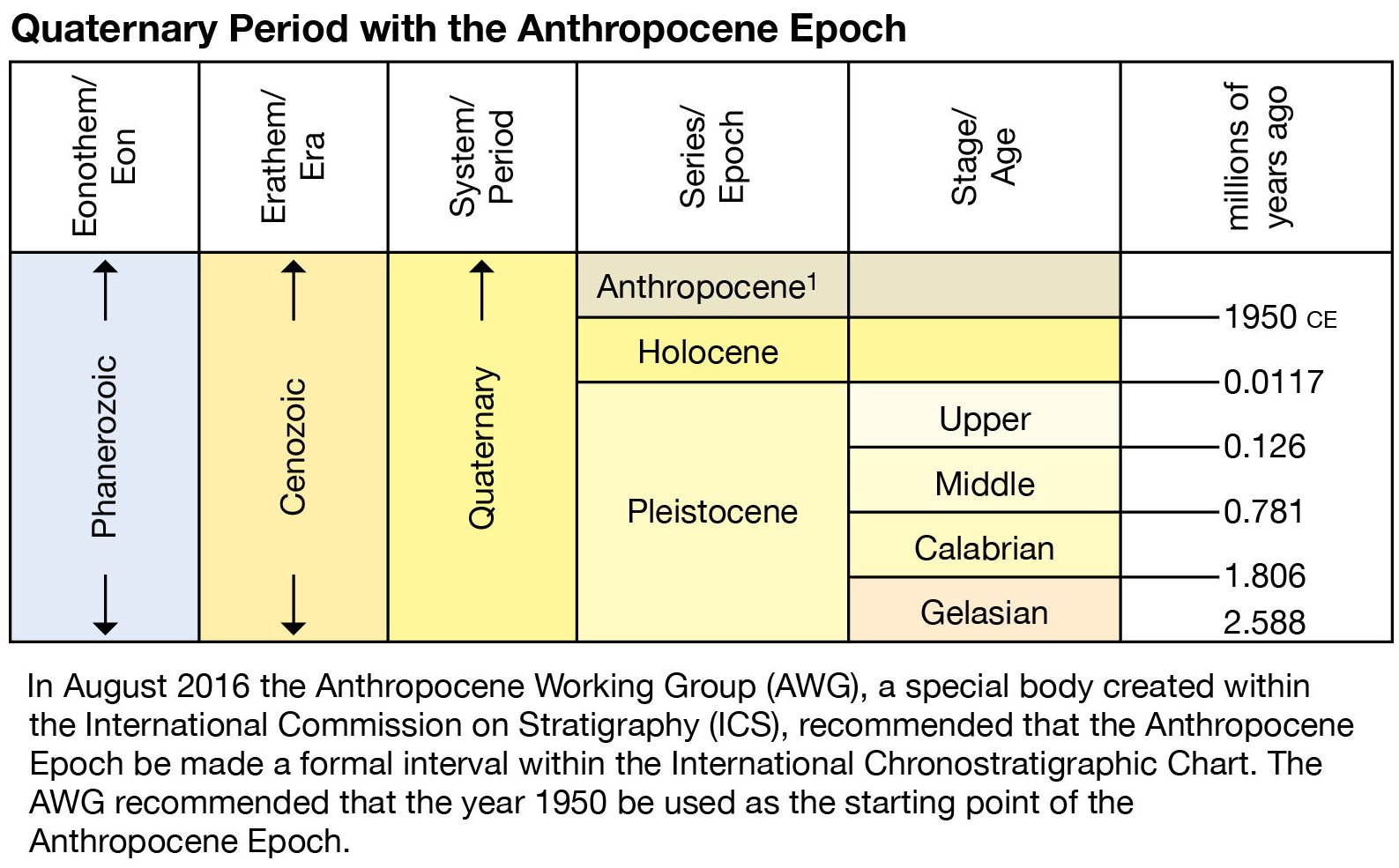Science & Technology
Anthropocene Epoch
- 29 May 2019
- 8 min read
Anthropocene Working Group (AWG) voted in favour of designating a new geological epoch i.e, the Anthropocene.
- The term 'Anthropocene' was coined in 2000 by Nobel Laureate Paul Crutzen and Eugene Stoermer to denote the present geological time interval in which human activity has profoundly altered many conditions and processes on Earth.
- The word combines the root "anthro", meaning "human" with the root "cene", the standard suffix for "epoch" in geologic time.
- The Anthropocene is distinguished as a new period either after or within the Holocene, the current epoch, which began approximately 10,000 years ago (about 8000 BC) with the end of the last glacial period.
Anthropocene Epoch
- Anthropocene Epoch, unofficial interval of geologic time, making up the third worldwide division of the Quaternary Period (2.6 million years ago to the present), characterized as the time in which the collective activities of human beings (Homo sapiens) began to substantially alter Earth’s surface, atmosphere, oceans, and systems of nutrient cycling.
- A growing group of scientists argue that the Anthropocene Epoch should follow the Holocene Epoch (11,700 years ago to the present) and begin in the year 1950. The name Anthropocene is derived from Greek and means the “recent age of man.”
- International Union of Geologic Sciences (IUGS) voted to recommend the Anthropocene as a formal geologic epoch at the 35th International Geological Congress. In order for this interval to be made official, it first must be adopted by the IUGS and the International Commission on Stratigraphy.
Geologic Marker or Golden Spike
- It is technically called the Global Boundary Stratotype Section and Point (GSSP) that is used to define the lower boundary of a stage on the geologic time scale. Some of the geological markers used in declaring Anthropocene epoch are:
- Artificial radionuclides: spread across the world by atomic bomb tests from the early 1950s would serve as the golden spike. The radionuclides are present almost everywhere from marine sediments to ice layers and even stalagmites and stalactites.
- The rate of soil erosion: increased from intensive agriculture and the land-use conversion will leave a mark in rock strata.
- Global warming: The rising air temperatures have caused glaciers and polar ice to melt and seawater to expand, both of which have contributed to a measurable rise in global sea level. Rising waters will change the stratigraphy in some places by submerging low-lying areas and allowing the ocean to deliver sediments farther inland than they do at present.
- The decline in seawater PH: the depth at which carbonate minerals (e.g., limestone and chalk) form in the ocean will be shallower than it was during preindustrial times. Many preexisting carbonate formations will dissolve in response to increases in ocean acidity, leaving a signature of striking dark layers of carbonate-depleted rock.
- The rapid extinction rate: is the most significant evidence of the Anthropocene in rock strata. Several ecologists have noted that the rate of species extinction occurring since the middle of the 20th century has been more than 1,000 times that of the preindustrial period, comparable to the pace of other mass extinctions occurring over the course of Earth’s history.
- The ongoing conversion of forests: and other natural areas to agriculture and urban land and accelerated climate change resulting from alterations to the carbon cycle.
- As a result, it is expected that there will be stark differences in the fossils found in layers of rock deposited worldwide during preindustrial times and those that follow.
When Did The Anthropocene Begin?
- Although the scale of humanity’s influence over Earth is large in modern times, there is much debate in the scientific community surrounding when human activities began to dominate the planet’s natural systems.
- Extinction of large Pleistocene mammals: is considered as the first signs occurred approximately 14,000 years ago. Though the incontrovertible proof linking humans to the demise of those mammals is lacking.
- Rise of agriculture: Others note that the rise of agriculture between 10,000 and 15,000 years ago might mark the onset of the Anthropocene.however, this start time may be problematic since it roughly coincides with the beginning of the Holocene Epoch.
- Dawn of the Industrial Revolution: a period of rapid change that brought about the advances in medicine, food production, and other technologies that fueled the recent growth in the world’s human population is also considered as the popular views among those who push for the formalization of the Anthropocene Epoch.
- Anthropocene Working Group: In 2016, recommended that the year 1950 serve as the starting point of the interval. This recommendation was based upon the idea that by this point in Earth’s history, plutonium isotopes caused by nuclear weapons testing fallout would be concentrated enough to serve as an observable signal in rock strata.
- Once a formal proposal is made by the AWG, it will be considered by several more groups of the International Commission on Stratigraphy.
- The final ratification will be made by the executive committee of the International Union of Geological Sciences.
A Global Boundary Stratotype Section and Point, abbreviated GSSP, is an internationally agreed-upon reference point on a stratigraphic section which defines the lower boundary of a stage on the geologic time scale. The effort to define GSSPs is conducted by the International Commission on Stratigraphy, a part of the International Union of Geological Sciences. Most, but not all, GSSPs are based on paleontological changes.
In July 2018, the ICS ratified a proposal to divide the Holocene into three stages: the Greenlandian stage (11,700 to 8,200 years ago), the Northgrippian stage (8,200 to 4,200 years ago), and the Meghalayan stage (4,200 years ago to the present), with GSSPs separating one stage from another.





